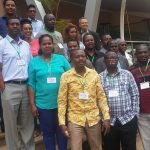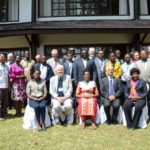By Ricky Robertson (IFPRI) It began with an innocent enquiry: do we have relative humidity data, under climate change for possible future situations, that could be used to think about a direct effect on animal productivity? Currently, in our economic modeling, the cattle, hogs, chickens, etc., are only indirectly affected by changes in feed/fodder prices >> Read more
Events & News
Crop and bio-economic modeling for an uncertain climate
By Gideon Kruseman (CIMMYT) The potential impact of climate change on agriculture and the complexity of possible adaptation responses require the application of new research methods and tools to develop adequate strategies. At a recent five-day training workshop titled “Crop and Bio-economic Modeling under Uncertain Climate,” scientists applied crop and bio-economic models to estimate biophysical >> Read more
Training workshop for the National Agricultural Investment Plans appraisal and design process for Sub-Saharan Africa: Introduction to Foresight Analysis
By Tim Sulser (IFPRI) With several members of AGRODEP and governmental/university researchers from Nigeria, Uganda, and the Ivory Coast, in September 2016 I led a successful training workshop focused on using strategic foresight analyses to inform the review and development process of country-level National Agricultural Investment Plans (NAIPs). We first worked to develop a common understanding >> Read more
Global Futures and Strategic Foresight participating in the Global Action Plan for Agricultural Diversity (GAPAD)
Global Futures and Strategic Foresight was invited to share their foresight perspective at the Global Action Plan on Agricultural Diversification (GAPAD) SDG2 Roundtable Forum in Nairobi, Kenya at the end of October 2016. GAPAD (gapad.org) is an initiative by the Association of International Research and Development Centers for Agriculture (www.airca.org) to promote agricultural diversification as >> Read more
Conservation Agriculture: strengthening crop production in marginal areas
Conservation Agriculture has the potential to enhance soil fertility and reduce erosion across 260,000 hectares (ha) of fragile and degraded cereal land in Tunisia, according to a joint study by the country’s National Institute of Agronomic Research (INRAT) and ICARDA. Conservation Agriculture (CA) – the practice of not plowing and leaving crop residue in fields >> Read more
Taxing red meat may cut emissions and disease
By Daniel Mason D'Croz, Keith Wiebe, and Sherman Robinson Growth in agricultural productivity and expanding markets have made more food available to more people than ever before. The options available to the average consumer visiting a supermarket are richer and more varied than at any time in history. But this abundance comes at a cost >> Read more
Structural Approaches and Technology Adoption: A new paper in Global Food Security
By Shahnila Islam Trends in population and income growth along with climate change pose significant risks to achieving sustainable food security. As challenges to the agricultural sector grow, we need improved tools to understand the risks, and to evaluate alternative solutions to mitigate some of these risks. In order for these tools to be useful, >> Read more
Reviewing 4 Years of IMPACT Outreach and Training
By Daniel Mason-D'Croz This month marks 4 years since the revamping of the IMPACT training curriculum to bring it up to date with the new version of the model. With more than 4 years now of experience, it seems appropriate to review and highlight some of the successes of these outreach and training efforts.
WorldFish hosts future fish supply and demand scenarios in ASEAN technical meeting
By Shahnila Islam and Chin Yee Chan From June 7-8th, WorldFish organized a technical workshop, “Future Fish Supply and Demand Scenarios in the ASEAN Region.” As a research activity of the Global Futures and Strategic Foresight project (GFSF), the IMPACT fish model developed by IFPRI, World Bank, FAO, and the University of Arkansas at Pine >> Read more
CIMMYT gathers partners to discuss biotic stress and crop model integration
By Kindie Tesfaye (CIMMYT) and Evgeniya Anisimova (PIM) When crops are damaged by other living organisms such as bacteria, viruses, fungi, insects and other pests, weeds or even cultivated plants competing for space and nutrients, we talk of the biotic stress. Biotic stresses are a major constraint to agricultural productivity in low and middle income >> Read more







